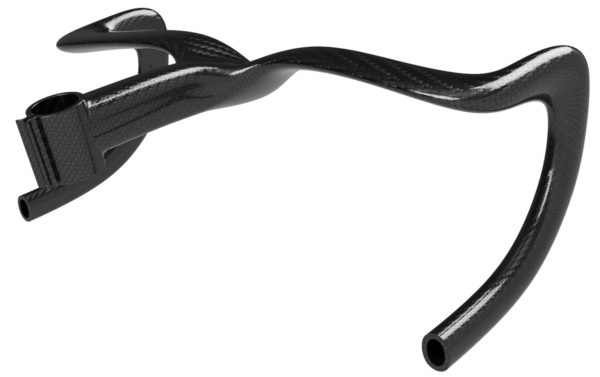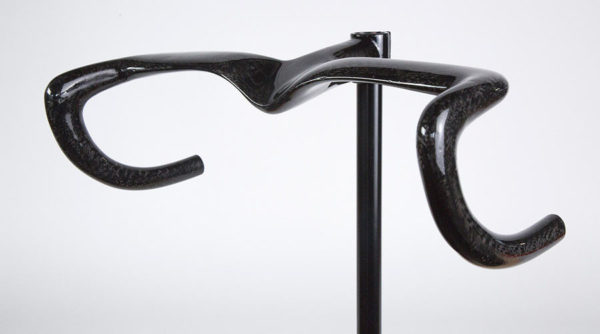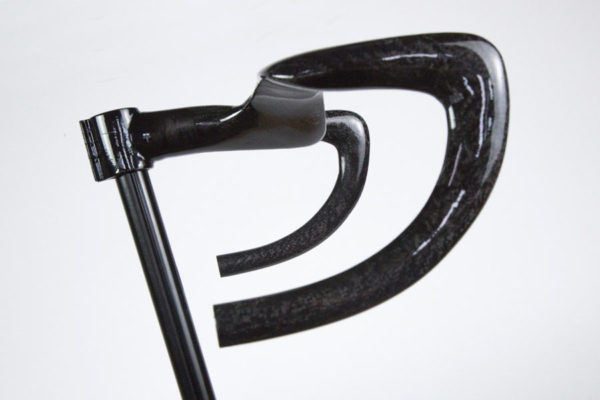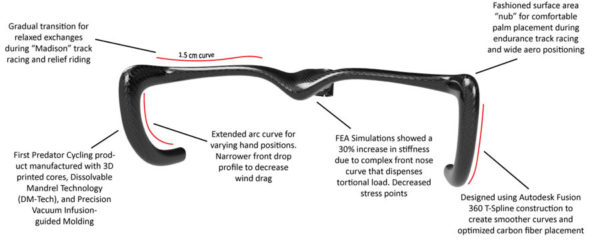Predator Cycling’s The Major Pilot is the next generation of their custom one-piece handlebar and stem unit. The original Major took an existing handlebar and stem, chopped the front off the stem and bonded them together with a massive, triangulated carbon and Kevlar section to create an unbelievably stiff part.
Now, they’ve taken years of carbon fiber construction experience and experimentation and developed their own method for monocoque construction that, they say, creates parts far better than anything you’re going to buy off the shelf…
To create the new Majors, which kick off with this Pilot track bar, they start by making the internal molds, or cores. Those are either 3D printing or injection molded thermoplastics to create the hard cores that the carbon fibers are then wound around. The construction is a combination of some raw fiber filaments being would around it, running continuously from the knuckle (where it clamps to the steerer tube) all the way to the ends of the drops, and UD and woven sections wrapped over those. All of that is done with dry fibers, not prepreg.
A vacuum infusion molding process then impregnate the carbon with a proprietary epoxy resin. The part is then cured, then goes into a post-curing process where it’s heated. During the curing process it’s heated to 120º and left to cure for 12 hours. In the post cure, it’s run through second and third heat cycles to help the epoxy resin meet its maximum potential. Those final cycles also melt the cores out of the bar.
“We’re able to get a better quality part by doing it this way,” said Aram Goganian, Predator’s founder. “It’s way easier to do it with pre-preg, but in order to get the same quality of carbon and finished product, we’d need to use an autoclave (basically a massive chamber that’s like a highly pressurized oven), which is how it’s done in aerospace industries, but it’s just not done in the cycling industry any more. To really get pre-preg parts done right, you need (an autoclave) because it gets all of the air out. Pre-preg inherently has small micro bubbles in it because it’s frozen before use, so infusing the resin into the part during construction like we’re doing results in a higher quality part.”
The track version shown here has started shipping early versions, and production versions will start shipping in December. They start cutting molds for the road bike version in December and start on the first batch in January if everything stays on track (They’re also in the process of moving from Los Angeles to a new, much larger facility near Nashville, TN). The Major Pilot retails for $749.
For the new road Major, they’ve made two prototypes under 250g, but target weight for the production ones is about 300g. The tops will look similar to the track bike, but the drops will look more traditional. They worked closely with Paul Swift from BikeFit to create the ergonomics and hand fit, then solicited feedback from pros racing in Europe to get the complete wishlist for what would make the ultimate road bike handlebar. All of that will be incorporated into The Major, as will integration for electronic wiring, internal cables and other features to work with modern standards. The first version will optimize layout for standard road bike routing, after which they might do one that spits the wires and cables out the back to work with bikes like the Madone or Venge. Expect retail to be about $699.
The clamp system isn’t modeled properly in these renderings, but it’ll be a standard two-bolt clamp with custom titanium hardware that uses nuts and bolts rather than putting any threaded parts directly into the carbon. So, if you end up breaking or stripping one, you just cut it out and replace it without damaging the carbon.
Fun Fact: Since our factory tour of Aram’s shop, they’ve continued to refine their in-house molding process, and that evolution is what’s led to these bars. Part of the testing process was building the roof for the Darth Vader Car:
Check out their timeline and photos of some early prototypes on their About Us page.



